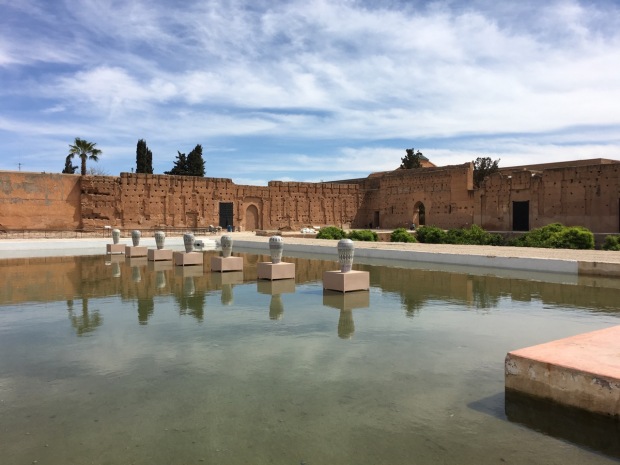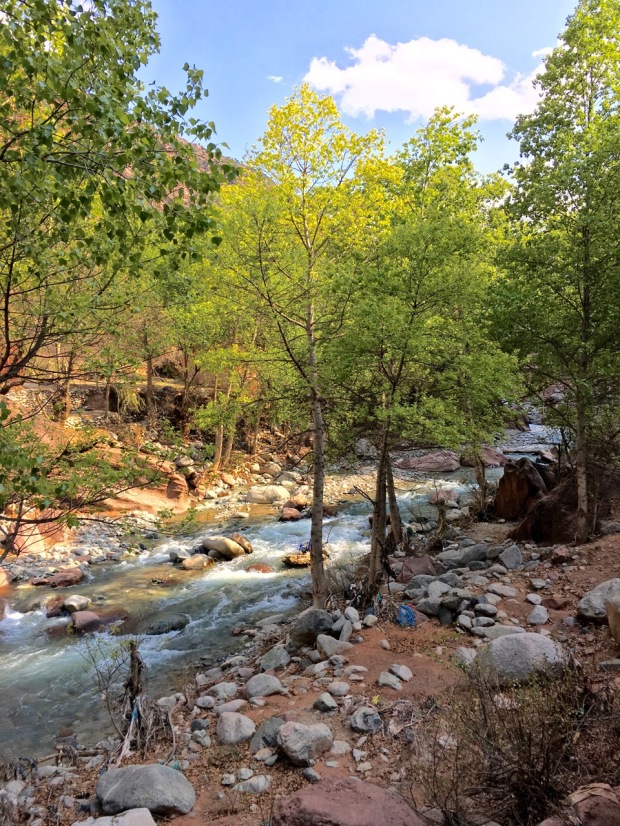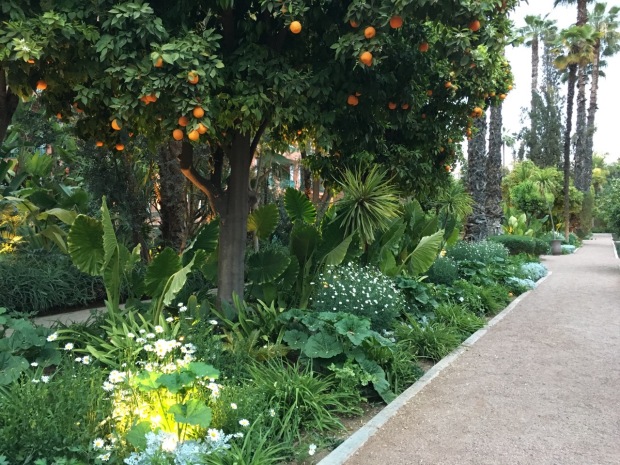
The serene Palais El Badiî, Marrakech, with sunken orchards
I’ve shared with you my two favourite gardens from Marrakech, Le Jardin Secret and Jardin Majorelle, but there were so many more that we saw and loved. I hadn’t previously thought of Morocco as particularly garden-loving, but my week exploring this busy city quite changed my mind.

Clever design linking (incredibly textured) cactus to water feature, or just happy coincidence?
Having had time to reflect upon my experience, I realise there are many lessons that will stay with me and impact my future design thinking. I’d broadly summarise them into four categories:
1. Colour

Wonderful colours of Marrakech, with enough uniformity in the display to allow any colour to look great. I can’t even begin to imagine what some of the contents were!
The use of colour in Marrakech is tremendously skilful. You see every colour under the sun and yet it is rarely overpowering or distasteful. They manage to use just sufficient common threads to pull it all together and the vibrant, cheery effect lifts your soul.

We had our fair share of tagines in Morocco, but most were not quite as artistically presented as this
A number of colours are seen more than others, reflecting historic influences and associated symbolism that’s still important today. The red, black, green and gold of Africa (think of their flags) and the red, black, green, yellow and white mentioned in the Quran. Green was supposedly Mohammed’s favourite colour (and also an Islamic symbol of nature and life; especially potent in the dry desert), and the gardens are overwhelming green; less flower colour than, say, a typical English garden. But they inject other colours in playful, innovative ways, bringing the garden to life.

A bright red cactus sculpture at La Momounia: I think I loved rather than hated it, in this context! It had other, similar friends.
Whilst the use of colour is not always predictable, at the same time it is somehow reassuringly consistent and I think this is why it works so well. Ideas are reinterpreted in new ways, but common themes run throughout the city, providing a satisfying ‘fit’.

These colourful restaurants at the foot of the Atlas Mountains were quite extraordinary. And there were literally kilometres of them. The tasteful boundaries may, on occasion, have been tested!

Naturally turquoise waters, pink soil and lime spring growth further along the river were perhaps slightly more calming!
2. Detail

So much thought and effort has gone into this exquisite and intricate design
The attention to detail seen in the fabric of buildings throughout Marrakech stops you in your tracks. It is, quite simply, mind-blowingly beautiful. Perfectly harmonious effects are created through a skilful balance of complexity and simplicity. The most intricately detailed carving will be in the purest, raw material. The time, effort, care and attention that has been put into the workmanship is clear for all to see; and just as well-loved gardens emit an atmosphere of joy, no matter how unconventional the design, so too do the buildings and hard landscaping of Marrakech.

What could be a poky little window has been ‘loved’ into a thing of beauty
I wonder how we have largely lost this desire for intricacy. Are we too focussed on having more, rather than quality? How can you not fall in love with something that has clearly had so much love put into it? With more money today than we have ever have, we sadly seem to be more focussed on price than on value, on cheap rather than expert workmanship, bigger houses rather than beautiful houses. I wonder when and if society will take more pride once again; take the time to make more effort.
3. Small spaces

Ceramic souk

Sparkly souk!
Which leads me on to the next learning. In the centre of Marrakech, everything is small. Small passageways, small shops, small houses, small courtyards. But gosh, is there beauty in this compactness. Everything has to earn its place and there is little wastage. Innovation shines through and every square centimetre of space is optimised.

The garden courtyard at the Riad Kheirredine, where we stayed. Even in a tiny space, the Islamic quadrant with central water feature design worked perfectly
As I sit in my teeny tiny airbnb cottage in London, looking out over the 2m by 1.5m roof terrace, I’m thinking this learning could be useful over the next few years! It’s exciting to have the opportunity to really work a space, to have a completely open my mind to new ways of doing things and Marrakech has given me the confidence that anything is possible!
4. Abundance

The ivy ground cover makes this garden feel so lush at Cyber Park (where wifi is also abundant and the park full of young people)
This isn’t a new learning as such, but Marrakech reinforced my view that abundance is one of the key success factors for gardens. In this dry, dry environment, many struggling gardens had large expanses of bare soil. If you could even call it soil. But my favourite gardens had no earth to be seen. There were entirely smothered in plants.

I loved the simplicity of the white garden beneath the fertile orange trees at La Mamounia. Especially because it was so abundant!
I’m currently reading a book called Planting in a post-wild world by Rainer and West. It’s a wonderful, wonderful book that I’d highly recommend to anyone with a garden, or even just an interest in gardens. It talks of how we are hard-wired with associations regarding nature, from the days when natural landscape type influenced life or death: our ability to find food and stay safe from predators.

Dense carpets of Azalea are well maintained at Cyber Park
Abundance equals life. And it equals future life; soil with vegetation rarely erodes, it stays moist for longer and without exposure to the sun, hosts more microorganisms and stays more fertile. It’s not surprising that full gardens appeal to us so much.

Looking out from a traditional Berber home, the landscape looks pretty green (did you spot the Eucalytus, bottom left?!)
The vulnerable soils of dry climates mean they benefit from abundance even more so than temperate ones. In nature, apart from the driest of desserts, most landscapes are abundant. Perhaps only with hardy grasses, but typically there are niche plants that will find their way into any bare space. The book describes how we have a tendency in our gardens to plant things far apart and keep soil bare under shrubs in a way that differs from nature, resulting in a different (and I’d say compromised) emotional response.

The entrance to the very expensive, but beautifully landscaped La Mamounia hotel

Lush and abundant but drought tolerant plantings at La Mamounia. This could definitely be Sydney, with Brugmansia, Strelitzia and Clivia!
If the gardens of Marrakech manage to create abundant plantings, why don’t we plant like this every time in our more tolerant climes?

Colour, colour, colour. Do you recognise the garden in this artwork? It absolutely sums up the essence of Marrakech
Over-ridingly, the gardens of Marrakech have developed very strong themes and these themes tie them together, providing a clear sense of place. As I wander around London I see Yucca next to roses, yellow variegated shrubs next to dark conifers and see that it isn’t just Australia that could do with a little more sense of place. It seems, we all have a lot to learn from Morocco. Who would have thought?

Wonderful mobile mast palm trees. Did you spot the one on the right? Innovation at its best: I love that the fronds are a bit wonky and asymmetrical!

Contrast (in the plants) and harmony (in the terracotta), perfectly balanced. This may not look great in central London, but in a Berber village, it’s perfect.

Again, contrast and uniformity, complexity and simplicity, perfectly balanced. And perfectly looked after. How we could learn from this exquisite taste.





I love your observations Janna.. Colour and abundance are the key points I’ve noted. With the Plant Collectors Fair on tomorrow here in Sydney, that could stimulate my purchasing!!
Thanks Libby. There’s even quite a bit of purple! Wish I was there to go to the Plant Collectors’ Fair. I came home from it with all sorts of purchases last year! Hope you got some goodies.
Great observations Janna. Is the same level of detailing and the skill and craftsmanship that goes with it seen in modern buildings? Or is it like elsewhere in the world that such detailing is deeply unfashionable and everything must be sleek and unadorned, and then euphemistically described as ‘contemporary’?
Hi Catherine. It’s a great question, although one that I don’t feel overly qualified to answer as we spent most of our time in the Old Arab Quarter, not seeing much modern architecture. My gut feel is that proportionately less money is put into detail today (possibly due to changes in the split of wealth), but that it is still very fashionable and certainly the culture of care and attention is still there, as seen in the immaculate market stalls. Whether a ‘contemporary’ shift is still to come, I don’t know, but I do feel the ethos of skill, craftsmanship and pride is fairly engrained in the culture. Let’s hope so!
Very interesting Janna – I appreciate your commentary on this — I will need to read through it a few time to gain even a small understanding of the sense of place (in this instance). I wonder if they use colour and intricate designs because the landscape is hard and somewhat brown? I too prefer the photo of the natural river compared to the rows of cafes tables in shocking pink!
It’s hard to tell why the bright colours originated, isn’t it? It could indeed be about the brown landscape but then I tend to associate bright colours with warm climates in general, which includes the wettest tropics. I know that I was very attracted to bright flower colours in Sydney and assumed that it was something to do with the sun and light. You have me intrigued now!
Yes I think you are right – hot climate = hot colours, even though it does not make sense to me (you would think hot climate = use cool colours – but I probably think this way because I come from a cool temperate climate).
It’s funny how already my thoughts on colour are changing. I saw some beautiful, pale yellow, native primroses the other day and just thought nothing could possibly beat them. Maybe it’s about going with the flow rather than trying to fight things with contrast??
Inspirational article for those of us who downsize and still wish for a colourful garden with imaginative use of plants.
Thank you, Elizabeth. Our imagination is usually the only thing stopping us!
I’m out of touch with city gardens, other than images from a magazine, but I would have thought the style in Marrakech would translate well and with the microclimate of London you’d stand a good chance with some of those ‘exotic’ plants too. Hope the house hunting is becoming more fruitful.
It is incredible to see the ‘exotic’ plants that happily grow in central London. It’s clearly significantly warmer than just outside the city (hooray!). I’m very excited to say that we now have a home here and I am pondering the design and planting of my new terrace as I type!
Thanks for a really interesting post as always, and congrats on your new home…lovely to have your own garden for designing and planting. Just as I read your thoughts on a having a sense of place I looked through some of my photos of the gardens near Questacon and the National Library in Canberra. There are now some wonderful beds of grasses, and winding paths in areas where school children visiting will sit (and run!) while having lunch under the Eucalypts trees. Very Australian! However, in a couple of photos, in the background there are the gorgeous Manchurian Pears…showing their wonderful red autumn colours. Deciduous trees provide such a relief on the Canberra landscape during times of heat and drought…so, to me, this mix works well for my sense of place in Canberra.
Thanks for the kind comments. The new areas along Lake Burley Griffin sound wonderful! What better way for school children to enjoy lunch on their trip to Canberra than under the shade of Eucalyptus trees? Especially as most of them will have come from much more urban areas. I completely agree on the Manchurian pears: they are such a defining feature of that stretch of the lake near the National Library. There’s nothing quite like them in autumn, with their tricolour leaves held on each and every tree. A very definite piece of Canberra’s sense of place.